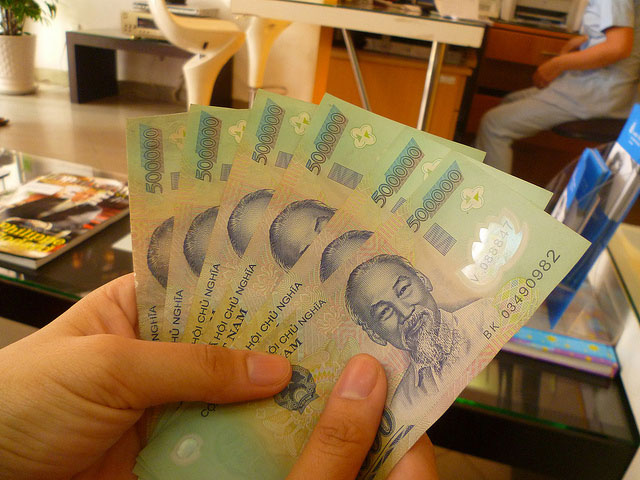Myanmar’s pledge to open the financial sector to foreign banks may bring unprecedented growth, but it will also put local competitors under pressure
By Philip Heijmans
The sight of large stacks of cold, hard cash is not uncommon in Myanmar. In a monetary system where coins no longer exist, and with bill denominations as small as 10 kyat, or $0.01, physical cash is often too voluminous for the average wallet. Where the day-to-day exchange of low-value currency is a nuisance, processing kyat at Myanmar’s local banks is an entirely different challenge.
At CB Bank in Yangon’s Mingalar Taung Nyunt township, customers patiently sit in a packed room with garbage bags filled with currency, waiting for their turn to manually fill out deposit papers. Across the room, a dozen tellers are hunched beside hundreds of newly bound stacks, counting money, 1,000 kyat ($1.05) at a time. They manually record the numbers into a log and hand them off to their supervisor – there is not a computer in sight.

Such is the state of Myanmar’s banks – hardly capable of offering services more diverse than a savings account. But that is all set to change if the ruling Union government gets its way.
In December, the Central Bank of Myanmar announced its intentions to liberalise the banking sector for the first time in more than 50 years by allowing foreign-owned banks to enter the market, with up to ten slated to become operational with limited services by the end of this year.
“Foreign banks have great potential in Myanmar. Much of the domestic financial system is dysfunctional, and there is a great hunger for access to trusted financial institutions from business and middle-class households alike,” said Sean Turnell, an expert in Myanmar’s economy and associate professor at Australia’s Macquarie University.
Like most emerging economies, Myanmar is largely cash-based, with only 5% of the country’s estimated 60 million population using banking services, according to a 2013 report by the International Finance Corporation (IFC). Nevertheless, Turnell believes that the banking sector will be subject to a rapid expansion once the market is opened to foreign players.
“I think building a plausible customer base of people with sufficient financial resources to need modern banking services will take very little time – for the first banks that move in,” he said. “Once that current hunger is sated, the market for higher-end financial services will become more competitive.”
According to the Central Bank of Myanmar, the banking sector consists of 22 locally-owned private banks – the largest among them is local mining magnate Aung Ko Win’s Kanbawza Bank, with $1.61 billion in deposits and $1.04 billion in loans as of 2012, according to research by financial advisory firm KPMG.
Without much in the way of capital, local banks are unable to issue many loans, while those loans that are given come with interest rates that are among the highest in the region, at about 13%, compared to an average of 5.4% in Singapore and 7.1% in Thailand, KPMG data shows.
What is more, outreach is sorely limited, with only 20% of the population able to access financial services, according to the IFC. Regardless of the high number of existing banks, deposit rates, meanwhile, are low at only 8%, according to KPMG.
In addition, bankers are worried that the sudden entrance of foreign banks in the market would leave them outmatched and force them to consolidate.

“This is a subject we have to consider very seriously – whether we are going to make a joint venture or go and operate independently,” said U Thein Tun, chairman of Foundation Bank and president of the country’s Banks Association (MBA).
“If the government allows outside banks to have commercial operations and they introduce new products, then we will not be able to compete given the scale of their investment.”
With those concerns in mind, the central bank said in June that foreign banks would only be given permission to operate wholesale services such as those catering to firms that deal with multi-national trading – and not as commercial banks for the time being.
“Weak portfolios in many domestic banks and the absence of a strong regulatory and institutional framework supportive of stability and risk management in the banking system suggest that caution in the liberalisation process is necessary,” said Cyn-Young Park, assistant chief economist at the Asian Development Bank (ADB).
“It would be advisable that the authorities phase in the entry of foreign banks gradually, by encouraging strategic partnerships and joint ventures first, and then proceeding to minority foreign shareholdings in domestic banks, and eventually – as conditions permit – issuing licenses for majority foreign-owned banks,” he said.
The central bank also announced that among the ten foreign banks it will choose to enter the market, some will be among the 35 banks with representative offices already here – a list that includes Malaysia’s Maybank, Singapore’s DBS Bank and ANZ.
Still, institutional hurdles remain. “I think right now there are not enough regulations in place and the government will need support from institutions such as the World Bank and the ADB in order for the central bank to better supervise all the banks – both foreign and local,” said Kim bun Socheat, managing director of Acleda Myanmar.
Part of the current issues facing the banks come as the central bank has had difficulty building its own capacity to support the growing needs of the financial sector, said U Aung Thura, chief executive of local consultancy firm Thura Swiss.
“The problem we are seeing is that the central bank has been too restrictive for the local industry to grow as they do not permit products they don’t have knowledge of,” he said. “If [Myanmar’s banking sector] had more freedom, the banks could do more.”

